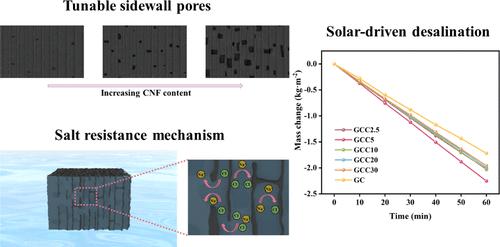具有多孔侧壁的明胶-纤维素纳米纤维气凝胶用于持久的太阳能海水淡化
IF 8.2
2区 材料科学
Q1 MATERIALS SCIENCE, MULTIDISCIPLINARY
引用次数: 0
摘要
太阳能驱动的界面蒸发代表了可持续淡水生产的一个有前途的战略。然而,其耐盐性差和机械不稳定性阻碍了其实际应用。本文以明胶/纤维素纳米纤维(CNF)为多孔基质,碳纳米管(CNTs)为光热组分,通过定向冷冻干燥制备了具有垂直排列通道的气凝胶蒸发器。值得注意的是,通过调整明胶/CNF的比例,成功地控制了孔隙大小、分布和侧壁孔隙。这些侧壁孔作为通道间离子交换单元,促进盐离子的扩散。与传统的认识相反,结果表明,更大的孔径本身并不能保证更好的耐盐性。相反,孔隙大小和侧壁孔隙分布之间的最佳平衡可以显著提高耐盐性和更高的蒸发速率。优化后的气凝胶在太阳能脱盐过程中表现出优异的耐盐性、优异的机械性能和长期稳定性,在一个太阳下的蒸发速率为2.25 kg·m-2·h-1(纯水)和2.20 kg·m-2·h-1 (3.5 wt %盐水)。此外,气凝胶对酸性/碱性废水和染料污染溶液都表现出卓越的水净化能力。该研究揭示了侧壁孔隙在垂直排列气凝胶通道中的关键作用,为气凝胶蒸发器设计中平衡高耐盐性和快速蒸发提供了特殊的见解。本文章由计算机程序翻译,如有差异,请以英文原文为准。

Gelatin–Cellulose Nanofibril Aerogels Featuring Porous Sidewalls for Durable Solar Desalination
Solar-driven interfacial evaporation represents a promising strategy for sustainable freshwater production. However, its practical application is hindered by poor salt resistance and mechanical instability. Herein, an aerogel evaporator with vertically aligned channels was fabricated through directional freeze-drying, using gelatin/cellulose nanofibrils (CNF) as the porous matrix and carbon nanotubes (CNTs) as the photothermal component. Remarkably, by tuning gelatin/CNF ratios, pore size, distribution and sidewall pores were successfully controlled. These sidewall pores function as interchannel ion exchange units, thus promoting salt ion diffusion. Contrary to conventional understanding, the results demonstrate that larger pore size alone does not guarantee better salt resistance. Instead, an optimal balance between pore size and sidewall pore distribution leads to significantly improved salt resistance and higher evaporation rates. The optimized aerogel exhibits outstanding salt resistance, superior mechanical performance and long-term stability in solar desalination, exhibiting high evaporation rates of 2.25 kg·m–2·h–1 (pure water) and 2.20 kg·m–2·h–1 (3.5 wt % brine) under 1 sun. Furthermore, the aerogel demonstrates remarkable water purification capabilities for both acidic/alkaline wastewater and dye-contaminated solutions. This study reveals the critical role of sidewall pores in vertically aligned aerogel channels, providing special insights for balancing high salt resistance and rapid evaporation in aerogel evaporator design.
求助全文
通过发布文献求助,成功后即可免费获取论文全文。
去求助
来源期刊

ACS Applied Materials & Interfaces
工程技术-材料科学:综合
CiteScore
16.00
自引率
6.30%
发文量
4978
审稿时长
1.8 months
期刊介绍:
ACS Applied Materials & Interfaces is a leading interdisciplinary journal that brings together chemists, engineers, physicists, and biologists to explore the development and utilization of newly-discovered materials and interfacial processes for specific applications. Our journal has experienced remarkable growth since its establishment in 2009, both in terms of the number of articles published and the impact of the research showcased. We are proud to foster a truly global community, with the majority of published articles originating from outside the United States, reflecting the rapid growth of applied research worldwide.
 求助内容:
求助内容: 应助结果提醒方式:
应助结果提醒方式:


